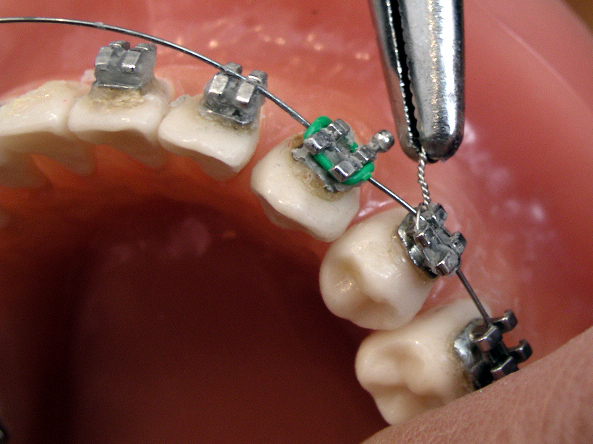Even though there are other products available, sometimes traditional braces are still the best option to straighten teeth. Less visible products like Invisalign are not for everyone because they do not always use enough force to move seriously crooked teeth.
People with small teeth might have questions such as “Do braces work on small teeth?” and “How do braces on small teeth look?” While these are valid questions, it is also important to ask: What is the problem you are trying to fix? Braces by themselves are not always the answer for changing the appearance of small teeth.
Do Braces Work on Small Teeth?
If teeth are crooked, crowded, or if the bite is misaligned, braces can help. Smaller teeth, however, might need different, or additional, treatment to create a better smile. A lot depends on whether teeth are shorter than average, more narrow, or both. Also, is the problem a single narrow tooth, or are all of the teeth narrow with large spaces throughout the entire mouth? The medical term for abnormally small teeth is microdontia. While it is not serious, it can make getting braces a bit more complicated.
Often, the problem with small teeth is more about proportionality than actual tooth size. Teeth, even if they are straight and have perfect alignment, might look too small for the person’s face and jaw structure. If that is the case, braces will not help. In fact, moving teeth will sometimes accentuate the appearance of teeth that do not “fit” the face.
While a dentist or an orthodontist might determine that braces will work to straighten a patient’s small teeth, they might also need additional cosmetic procedures to give them the results they are looking for.
How Do Braces on Small Teeth Look?

People are sometimes reluctant to wear traditional braces because of the way they look. Adults, in particular, often resist the idea of the “metal mouth” they were used to seeing as kids. Someone with small teeth might be even more concerned about the look of brackets overwhelming their smile.
The old-fashioned silver bands that surrounded teeth are rarely used with today’s braces. Instead, small, square brackets are affixed to the front of the teeth. As materials and techniques have improved over the years, brackets have gotten smaller. This helps them fit on smaller teeth, while also making them look less prominent.
“Clear” braces are also an option. They are not really clear but are ceramic or porcelain. They match the natural shade of the teeth, making them less noticeable.
Lingual braces have brackets attached to the backs of the teeth. Unless the patient opens wide, these remain out of sight. Unfortunately, there is even less space behind the teeth than in front, so lingual braces may not fit on someone with very small teeth.
The smaller the teeth, the larger the brackets might look. But with the sizes and colors that are now available, braces on small teeth should not look that much different than those on larger teeth.
When Teeth are Shorter Than Average
A common form of microdontia is when teeth look abnormally short. Often, the teeth are fine and are straight with a healthy bite. The gums, however, grow too long, covering up more of the teeth than is normal.
Gum reshaping will correct most instances of short teeth. The procedure involves trimming and recontouring the gums so they expose more of the teeth. If there is also a problem with crookedness, crowding, or malocclusion (overbite, underbite, or crossbite) braces can be fitted after the gum reshaping.
Narrow Teeth

Another form of microdontia is narrow teeth, called peg laterals. The teeth might be skinny, pointy, or cone-shaped. Having a whole mouthful of narrow teeth is rare. When it does happen, an adult can look as if they still have their baby teeth. More often, only one or two teeth are affected.
There are two possible problems with braces on narrow teeth. First, if the surface area is too small, the orthodontist will have trouble finding a bracket that will fit securely. Second, while the braces can move the teeth into position, their narrowness means there will likely be spaces on one or both sides. If the braces move the teeth to close those gaps, the rest of the teeth may be pushed further out of line.
For example, picture a mouth where every tooth is narrow. Braces that push them together will force them all toward the front of the mouth. This can harm the structure of the entire jaw.
Braces might be used to move narrow teeth into position, but they might need the help of another procedure to fill in the resulting spaces.
Alternatives to Braces on Small Teeth
Just because someone has small teeth does not mean they are out of luck to have a nice, straight smile. There are ways that narrow teeth can be augmented so they are the appropriate size.
Gum reshaping
As mentioned above, gum reshaping can help lengthen the amount of tooth that shows. If the teeth are straight, that might be all that is needed. If not, braces can be put on afterward.
Dental bonding
A dentist can use dental bonding to sculpt a new shape for a tooth. Composite material similar to what is used for dental fillings is added where necessary to a tooth, then molded to the desired shape. It looks real thanks to its natural color and can fix both short and narrow teeth.
Veneers
Veneers are similar to bonding, but only cover the front of the teeth. They are most often used to cover chips, cracks, or stains. Depending on the problem with a small tooth, they might be an option.
Crowns
Dental crowns completely cover a tooth with a realistic-looking cap. The concept of putting a normal-sized cover on top of a smaller-than-normal tooth might sound like a perfect solution. It can work well in some cases. But the procedure to fit a crown involves drilling away a significant portion of the real tooth. If a tooth is small, to begin with, this could do more harm than good.
Getting Help for Small Teeth
Braces on small teeth can work, but they might present some problems. Depending on the individual, there could be an option that will work better. Start by asking your dentist what they recommend. If you need to find a dentist near you, click on our link and we’ll help you get started.


